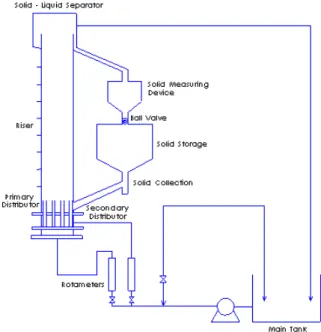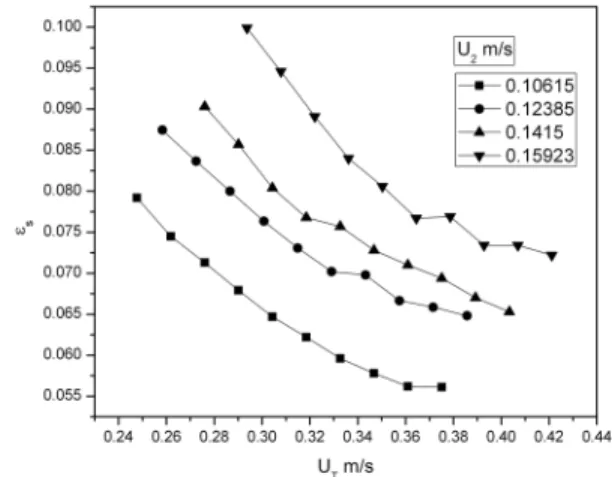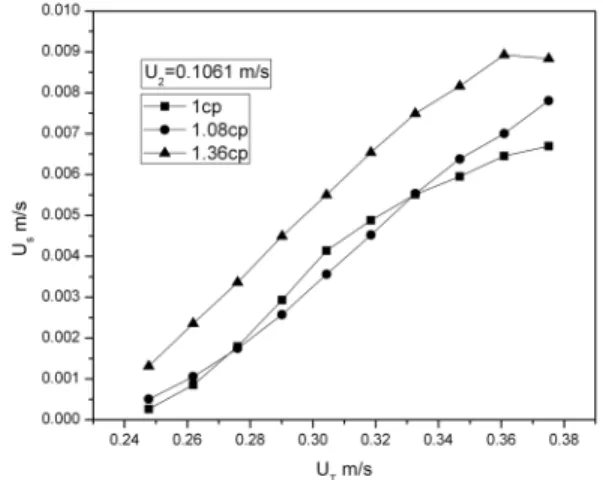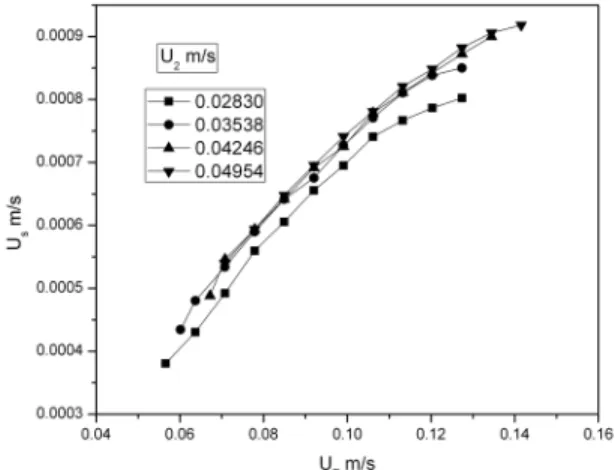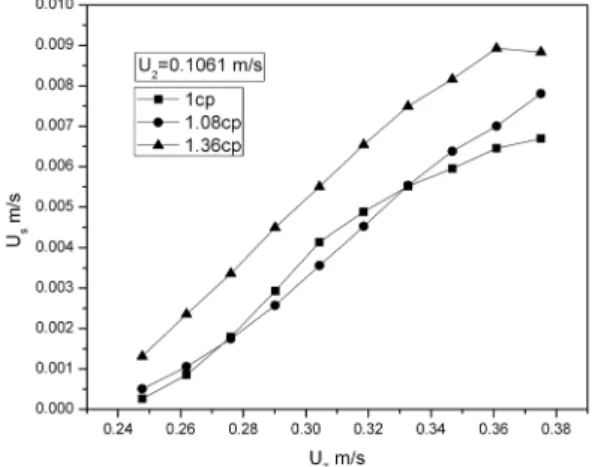ISSN 0104-6632 Printed in Brazil
www.abeq.org.br/bjche
Vol. 32, No. 04, pp. 849 - 856, October - December, 2015 dx.doi.org/10.1590/0104-6632.20150324s00003026
Brazilian Journal
of Chemical
Engineering
SOLID HOLDUP AND CIRCULATION RATE IN A
LIQUID-SOLID CIRCULATING FLUIDIZED BED
WITH VISCOUS LIQUID MEDIUM
N. Gnanasundaram
1*, M. Loganathan
1and K. Perumal
21Mass Transfer Laboratory, Chemical Engineering Division, School of Mechanical and
Building Sciences, VIT University, Vellore-632014, Tamilnadu, India. Phone: 91-416-2202595
E-mail: gsnirmala@vit.ac.in 2
Chemical Engineering Department, School of Engineering and Science, Curtin University of Technology, Sarawak - 98009,Malaysia.
(Submitted: October 12, 2013 ; Accepted: September 13, 2014)
Abstract - Experiments were conducted in a liquid-solid circulating fluidized bed with different viscous liquids and particles to study the hydrodynamics, average solid hold up and solid circulation rate. The effects of operating parameters, i.e., primary liquid flow rate in the riser, auxiliary liquid flow rate, total liquid flow rate and viscosity of the liquid were studied for solids of different density and particle size. Results show that the circulating fluidization regime starts earlier for more viscous solutions because of the decrease in critical transitional velocity. The onset of solid holdup increases with an increase in liquid viscosity for sand and for glass beads. The solid circulation rate increases with an increase in total velocity and auxiliary velocity, and also increases with increasing viscosity.
Keywords: - LSCFB; Viscous effect; Axial solid holdup solid circulation rate.
INTRODUCTION
Conventional liquid-solid fluidization has been studied intensively and almost all liquid-solid sys-tems show particulate fluidization, resulting in uni-form axial and radial solid holdup at liquid velocities below the particle terminal velocity (Richardson, 1954; Kunii and Levenspiel, 1991; Di Felice, 1995). The advantages include: enhanced mass and heat transfer rates, improved interphase contact, better control of solid holdup, less back mixing and higher throughput. For processes involving large amounts of small or light particles in liquid media and liquid-solid reactions and in which the particles must be circulated for frequent regeneration, liquid-solid circulating fluidized beds have considerable promise as ideal liquid - solid contactors. Due to these
ad-vantages, liquid-solid fluidized beds are used in the field of biochemical (Zhu et al., 2000), environmen-tal, metallurgical and petrochemical Engineering. A better understanding of this process can be achieved by focusing on the hydrodynamics and transport phenomena. A typical Liquid-Solid Circulating Flu-idized Bed (LSCFB) consists of a riser with primary and secondary flow, a solids separator and a down-comer, which feeds the solids to the riser.
and its overall operation. Liang (1996; 1997) and Zheng and Zhu (1999) reported a uniform distribu-tion of solid holdup in the axial direcdistribu-tion and a non-uniform radial distribution in the riser. Natarajan et al. (2008) measured the solid velocity and solid hold up by varying the solid density and solid inventory and concluded that the solid inventory in the down comer and solid feeding system strongly influenced the solid velocity, phase holdup and operating range of LSCFB. Vidyasagar et al. (2008; 2009) studied the flow properties at various liquid velocities and the solid inventory in the down comer at two differ-ent locations of the primary liquid distributor, and also reported the hydrodynamics by three experi-mental methods keeping the solid feeding structure similar.
Zheng (2004), Cho et al. (2005) and Shin et al. (2005) studied the effects of liquid viscosity on hy-drodynamics, transport properties, heat transfer co-efficient and radial dispersion with the riser operated in the variable inventory mode. The effect of liquid viscosity on the fixed inventory mode was studied by Vidyasagar et al. (2011) for different solid inventories and macroscopic flow properties such as pressure gradient, critical transitional liquid velocity to circu-lating fluidized bed regime, average solid holdup, axial solid hold up distribution and solid circulation rate.
Many industrial processes require a viscous liquid as a processing fluid and it is very important to know the influence of viscosity on hydrodynamics, espe-cially on the solid holdup and the solid circulation rate in the riser of an LSCFB. A critical analysis of the literature indicated the absence of studies of the effect of liquid viscosity on macroscopic properties with various particles of different density. Hence the present investigation focused on the study of the effect of liquid viscosity, liquid flow rate and particle density on macroscopic flow properties, namely the pressure gradient, average solid holdup distribution, axial flow and solid circulation rate for LSCFB risers.
EXPERIMENTAL
The liquid-solid circulating fluidized system con-sisted of a riser, liquid solid separator, solid recycle down comer and a distributor (Figure 1). The riser was made of acrylic with an inside diameter of 0.1 m. The total height of the column was 2.4 m and the test section height from the auxiliary distributor plate was 2.0 m. The base of the riser had two distributors, one for primary liquid flow and the other for auxiliary
liquid flow into the riser. The primary distributor had stainless steel tubes that occupied 18% of the total bed area. The secondary liquid distributor had a brass plate with 2 mm openings, along with a fine mesh that gave 7.3% of the total cross sectional area. Initially, the liquid from the reservoir was pumped and admitted as two streams. The main stream en-tered the riser through the primary liquid distributor and the secondary through the auxiliary distributor fitted via respective rotameters. The auxiliary liquid stream controlled the quantity of particles recirculat-ing from the storage vessel into the riser and its func-tion was to fluidize the particles at the base of the riser. When the secondary liquid flow rate was set to zero, no particles can enter the riser from the solid storage tank due to the high resistance caused by the particle layer at the bottom of the riser. The riser was provided with pressure taps at 150 mm intervals. The pressure taps were connected to a multilimb manome-ter to record the pressure drop across the column during the experiment. Liquid and solids co-cur-rently moved upward through the riser and separated in the liquid-solid separator. The separated solids returned to the down comer through the solids re-turning point and the solid circulation rate measuring devices. The liquid left the liquid-solid separator at the liquid outlet placed at the separator and moved to the reservoir.
Figure 1: Schematic of the Experimental LSCFB Setup.
meters at short intervals until the bed expanded to its entire length. When the solids were about to entrain from the top of the riser, the secondary liquid was introduced and circulation between the riser and the down comer started. The riser had pressure taps at regular intervals of 0.150 m connected to a multilimb manometer to measure the pressure drop in each section of the riser. The solid circulation rate was determined by closing the ball valve and measuring the time required to accumulate a definite height of solids above the valve. The solids height in the tube and its weight were precalibrated for each fluid-solid system to estimate the weight of solids circulated per unit time. The solid circulation rate measurement was repeated thrice to check the consistency of sys-tem performance. The experiments were continued by increasing the primary liquid velocity until the transport regime was reached. This procedure was repeated for various fixed secondary velocities. Ex-periments were conducted with particles of different sizes and densities. The sizes and quantity of the particles were obtained by sieving and conformed to the standards. The physical properties of liquid and solid used in the present study are covered in Tables 1 and 2.
Table 1: Physical properties of the solid and operating velocities of liquid used in present study.
Variables Range
Primary liquid velocity, m/s
0.02477 - 0.099 m/s (sand) 0.1344 - 0.2618 m/s (glass bead) Auxiliary liquid velocity,
m/s
0.028 - 0.04954 m/s (sand) 0.1061 - 0.1592 m/s (glass bead) Total Liquid velocity,
m/s
0.056-0.1415 m/s (sand) 0.2477-0.42109 m/s (glass bead) Viscosity of liquid, cP 1.00 -1.36
Particle density, kg/m3
2400 (sand) 2490 (glass bead)
Table 2: Physical properties of the liquids and solids used in the present study.
Fluidizing liquid
Density (kg/m3)
Viscosity (cp) Terminal velocity of particles (m/s) Sand Terminal velocity of particles (m/s) Glass beads
Tap water 1000 1 0.0700 0.2919
5 vol % aqueous glycerol
1011 1.085 0.0675 0.2626
15 vol % aqueous glycerol
1036 1.36 0.0614 0.2562
All experiments were carried out at ambient tem-perature. The solid holdup was measured by noting the pressure gradient at different locations along the
riser. Average solid holdup was determined for each measured section using Equation (1).
s l l
s lP
g
Z with 1
s (1)
RESULTS AND DISCUSSION
The fluidization in the liquid-solid system is con-trolled by the liquid flow rate. With increasing flow rate, the liquid-solid system passes through fixed bed, fluidized bed, particulate fluidization regime and then the circulating fluidization regime. Visual observation of the liquid-solid circulating fluidiza-tion phenomenon was possible because the test sec-tion was made of acrylic.
The fluid in the liquid-solid circulating fluidized bed was controlled by varying the primary liquid flow rate and the auxiliary liquid flow rate. The function of the auxiliary flow was to push the solids to the top of the riser and allow the solids from the solid feeding pipe to enter into the riser. The experi-mental data of the present study cover a wide range of average solid holdup εs, solid circulation rate Gs
and solid velocity Us in the circulating fluidization
regime. All these parameters are controlled by
ad-justing the ratio of primary and secondary flow rate and hence the auxiliary distributor and solid feeding pipe act as a non-mechanical valve.
Pressure Drop Profile
Figure 2 shows the variation of the pressure gra-dient plotted as a function of total superficial velocity at two axial locations, i.e., 1.5 m and 0.75 m along the length of the riser for a μ = 1.36 cp viscous solution for sand and Figure 3 for a glass bead system with
velocity for sand is 0.0614 m/s, whereas for glass beads it is 0.2562 m/s for μ= 1.36 cp, which in turn changes the critical transitional velocity from con-ventional to CFB for both the solids. It was further observed that the circulating fluidized bed regime started before the superficial total liquid velocity reached the terminal velocity of the particles for glass beads due to the early equivalence of the interstitial liquid velocity to the terminal velocity of the particles. Vidyasagar et al. (2011) studied dense phase expansion, fluidized bed and CFB pressure drop profiles corresponding to a state of transition from conventional to CFB regime for various vis-cous solutions in glass bead systems.
Figure 2: Variation of pressure gradient along the riser with total liquid velocity- Sand-glycerol (1.36 cP).
Figure 3: Variation of pressure gradient along the riser with total liquid velocity for Glass beads-glycerol (1.36 cP).
Average Solid Holdup
The variation of solid holdup in the riser was plotted in Figure 4 for the glass beads-water system and in Figure 5 for the sand-water system for varying
total velocity UT and constant auxiliary velocity (U2).
Natarajan et al. (2008) and Vidyasagar et al. (2008) showed that solid holdup depends upon the auxiliary liquid velocity and initial solid inventory for a water-particle system. The present study also demonstrated that, for the given auxiliary velocity, the solid holdup decreased with respect to the corresponding increase in primary and total velocity. It can also be seen that, with an increase in auxiliary velocity, the solid holdup in the riser increases. This is due to the fact that, at low auxiliary velocities, there is a slow movement of solids in the return pipe with low solid loading in the riser, and the flow of solids into the return pipe increases with an increase in secondary velocity.
Figure 4: The effect of total velocity on the average solid holdup for the sand-water system.
Figure 5: The effect of total velocity on the average solid holdup for the glass beads-water system.
the developing flow region and the fully developed flow region. In the developing flow region located in the lower portion of the riser, solids are accelerated along with the decrease of solid holdup. At higher total velocity, the solid holdup shows a plateau, which indicates that the solid flow enters into the fully developed zone, which is consistent with the results of earlier studies.
Effect of Liquid Viscosity on Solid Holdup
There is not much information available in the literature on the effect of liquid viscosity on solid holdup for solids of different density and size. The effect of liquid viscosity on solid holdup is shown in Figure 6 for sand-glycerol and for glass beads-glycerol of viscosity 1.36 cP. It can be seen that, with the decrease in solid density, solid holdup is shifted towards the left, indicating that solid circulation begins at lower velocity, corresponding to its termi-nal velocity; solid holdup was found to be higher for low liquid velocity. Maximum solid holdup was reported for the glass bead-glycerol system as larger particles lead to higher solid holdup. It is also noted that the glass bead-glycerol system needs higher superficial velocity to fluidize in the circulating regime because its terminal velocity is higher. For the given superficial velocity, solid holdup increases with an increase in solid density. Similar results have been reported by Natarajan et al. (2008) for a water system using silica gel and resin.
Figure 6: Effect of the density of particles on the variation of solid holdup with variation in total ve-locity.
For the same set of auxiliary liquid velocities for the water system, an increase in solid holdup was observed with increasing viscosity of the liquid. As shown in Figure 7 for sand-glycerol and in Figure 8
for the glass bead system. For the given total liquid velocity, the average solid holdup decreases with an increase in superficial total velocity as more particles are entrained, which in turn shows lower solid con-centration. Glass beads of higher density and greater size required more superficial velocity to achieve the same holdup because their terminal velocity is higher. For the same total velocity, the solid holdup decreases with an increase in superficial velocity (Figure 2 and 3) for the water system, but with an increase in viscosity solid holdup is found to increase for both the sand and glass bead systems. This in-crease in solid holdup is due to the fact that the cir-culating fluidization regime starts much earlier for the viscous system because the terminal velocity de-creases with an increase in viscosity. This observa-tion is similar for both solids, shown in Figures 7 and 8. Hence, it can be concluded that both particle size and viscosity influence the solid holdup in a riser.
Figure 7: The effect of viscosity on the average solid holdup for the sand-glycerol system.
Solid Circulation Rate
Effect of Primary and Auxiliary Velocity on Solid Velocity
The quantity of the solids fed and the total liquid velocity were the variables affecting the solid cir-culation rate in a circulating fluidized bed. An in-crease in primary liquid velocity or auxiliary liquid velocity increases the total velocity in the riser. Figures 9 and 10 show the variation of solid velocity for the sand-water and glass bead-water systems respectively. For a given total velocity, the solid velocity increases with an increase in auxiliary liquid velocity, as more solids were introduced into the riser from the down comer, its function being to regulate the solid flux. On the other hand, when the auxiliary velocity is low, the solid input to the riser is low and the operating range in the solid velocity is small.
Figure 9: The effect of total velocity on the solid circulation rate for the sand-water system.
Figure 10: The effect of total velocity on the solid circulation rate for the glass bead-water system.
The data showed that the solid velocity curve rises steeply with an increase in auxiliary liquid locity. It is also noted that an increase in solid ve-locity with liquid veve-locity shows two regions. In region 1, the solid velocity increases rapidly with increasing velocity, followed by region 2, in which the solid velocity increases insignificantly, as re-ported by Zheng (1999). In Figures 9 and 10 for both systems, zone 1 is found to increase linearly, whereas in zone 2 this is not clearly shown due to the differ-ence in the configuration of the non-mechanical valve of the present study from that of other authors. In order to achieve a high solid velocity, the liquid velocity should be higher than the critical velocity.
Effect of Liquid Viscosity on Solid Circulation Rate
Less literature is available on the effect of liquid viscosity for solids of different density and size that show the effect on solid circulation rate. Moreover, there is no information available in the literature for the variation of solid velocity with a change in den-sity for viscous solutions. Natarajan et al. (2008) studied the effect of particle density on solid circu-lation rate for the water system. Figure 11 shows the variation of solid velocity with a variation in liquid velocity for solids of different density and size. It can be noted that flow behavior is similar with increasing trends for both the solids. Terminal velocities for lighter particles were low, resulting in early circula-tion of solids, which in turn increases the solid ve-locity rapidly; its transition from the initial zone to the fully developed zone is shown. Hence, the solid circulation velocity for sand (lower density material) is higher than that of glass beads (higher density). It is also worthwhile to note the effect of solid velocity on the total velocity curve, which shifts towards the left for lighter particles. The maximum liquid ve-locity corresponding to the maximum solid veve-locity is lower for low density material and for a given auxiliary velocity, the solid input to the riser in-creases and the liquid velocity at which circulation starts is lower for the lighter material.
constant auxiliary velocity. A similar trend was also observed for the glass bead–glycerol and sand-glycerol systems with µ = 1.36 cP. The solid cir-culation velocity was found to be higher for the viscous solution than for water due to the decrease in terminal settling velocity, which in turn decreases the critical transitional velocity. Therefore, circulating fluidization starts earlier for the glass bead-glycerol system, as depicted in Figure 12. The effect of liquid viscosity studied by Vidyasagar et al. (2011) for a glass beads–glycerol system shows a similar result. For the sand system of varying viscosity, as shown in Figure 13, the solid circulation velocity increases for viscous solutions of 1.08 and 1.36 cP. For the more viscous solution, the circulating fluidized bed re-gime starts much earlier with more solid circulation velocity. However, the maximum solid circulation velocity was observed for the solution of viscosity 1.08 cP.
Figure 11: Effect of particle density on the variation of solid circulation rate with the variation in total velocity.
Figure 12: The effect of viscosity on the solid velocity for the sand-glycerol system.
Figure 13: The effect of viscosity on the solid velocity for the glass bead-glycerol system.
CONCLUSIONS
The effect of liquid flow rate, primary and sec-ondary velocity, viscosity of the liquid and particle density were studied in a liquid-solid circulating fluidized bed. The average solid holdup decreased with an increase in primary and total velocity and was found to increase with an increase in auxiliary velocity. For a given total liquid velocity, the solid holdup was found to increase with an increase in viscosity for both the sand and glass bead-glycerol systems. The increase of solid holdup with an in-crease in viscosity is due to the low critical transi-tional velocity and the increased energy spent to entrain solid particles. It is found that, with a de-crease in solid density, solid holdup shifted towards the left, indicating that solid circulation begins at a lower velocity, corresponding to its terminal velocity. The solid circulation rate was found to increase with an increase in total velocity and auxiliary velocity. The circulating fluidized bed regime was reached at lower velocity with an increase in liquid viscosity from 1 cp to 1.36 cp due to the enhancement of shear stress acting on the particle, which results in an increase of drag force acting on the fluidized particles. It was also found that the maximum liquid velocity, corresponding to maximum solid velocity, was lower for the lower density material.
NOMENCLATURE
dp particle diameter
g acceleration due to gravity (m/s2) Gs Solid circulation rate (kg/m
2
.s)
UT Total superficial liquid velocity (m/s)
U1 Primary or main liquid velocity (m/s)
U2 Secondary or auxiliary liquid velocity (m/s)
Ut Particle terminal velocity (m/s)
Us Particle velocity (m/s)
Greek Symbols
εs Average solid holdup
ℓs Density of solids (kg/m3)
ℓl Density of liquids (kg/m3)
ℓm Density of medium (kg/m3)
REFERENCES
Ahu, J. X., Zheng, Y., Karamanev, D. G., Bassi, A. S., (Gas-)liquid-solid circulating fluidized beds and their potential applications to bioreactor en-gineering. Can. J. Chem. Eng., 78, 82-94 (2000). Basava Rao, V. V., Sailu, Ch. and Sandilya, D. K.,
An experimental Study of liquid particle flow in circulating fluidized bed. Chem. Eng. Commun., 94, 353-367 (2007).
Cho, Y. J., Song, P. S. and Lee, C. G., Liquid radial dispersion in liquid solid circulating fluidized beds with viscous liquid medium. Chem. Eng. Commun., 192, 257-271 (2005).
Felice, R. Di, Hydrodynamics of liquid fluidization. Chem. Eng. Sci., 50, 1213-1245 (1995).
Kunii, D. and Levenspiel, O., Fluidization Engi-neering. Butterworth-Heinemann Publishers, Bos-ton (1991).
Kuramoto, K., Tanaka, K., Tsutumi, A., Yoshida, K. and Chiba, T., Macroscopic flow structure of solid particles in circulating liquid-solid fluidized beds. J. Chem. Eng. Japan, 31, 258-265 (1998). Liang, W. G., Zhang, S. L., Zhu, J. X., Jin, Y., Yu, Z.
Q. and Wang, Z. W., Flow characteristics of the liquid solid circulating fluidized bed. Powder Technol., 90, 95-102 (1997).
Liang, W. G., Zhu, J. X., Jin, Y., Yu, Z. Q., Wang, Z. W. and Zhou, J., Radial non uniformity of flow in a liquid solid circulating fluidized bed. Chem. Eng. Sci., 51, 2001-2010 (1996).
Natarajan, P., Velraj, R. and Senniraj, R. V., Effect of various parameters on the solid circulation rate in
a liquid-solid circulating fluidized bed. Asia-Pac. J. Chem. Eng., 3, 459-470 (2008).
Natarajan, P., Velraj, R. and Seeniraj, R.V., Studies on regime transition, operating range and system stability in a liquid solid circulating fluidized bed. Chem.Eng. Technol., 32, 572-579 (2009). Natarajan, P., Velraj, R. and Seeniraj, R.V.,
Applica-tion of drift flux model in liquid-solid circulating fluidized bed. Chem. Eng. Commun., 195, 1144-1158 (2008).
Natarajan, P., Velraj, R. and Senniraj, R. V., Effect of various parameters on the solid holdup in a liquid-solid circulating fluidized bed. Int. J. Chem. React. Eng., 6, A, 44 (2008).
Richardson, J. F. and Zaki, W. N., Sedimentation and fluidization: Part I. Trans. Inst. Chem. Eng., 32, 35-53 (1954).
Roy, S., Kemoun, A., Al-Dahhan, M. and Dudukovic, M. P., A method for estimating the solid circula-tion rate in a closed loop circulating fluidized bed. Powder Technol., 121, 213-222 (2001). Roy, S., Kemoun, A., Al Dahhan, M. H. and
Dudu-dovic, M. P., Experimental investigation of hy-drodynamics in a liquid-solid riser. AIChE Jour-nal, 51, 802-835 (2005).
Shin, K. S., Song, P. S., Lee, C. G., Kang, S. H., Kang, Y., Kim, S. D. and Kim, S. J., Heat transfer coefficient in viscous liquid-solid circulating fluidized beds. AIChE Journal, 51, 671-677 (2005).
Vidyasagar, S., Krishnaiah, S. K. and Sai, P. S. T., Hydrodynamics of liquid solid circulating fluid-ized bed: Effect of dynamic leak. Chem. Eng. J., 138, 425-435 (2008).
Vidyasagar, S., Krishnaiah, K. and Sai, P. S. T., Com-parison of macroscopic flow properties obtained by three different methods of operation in a liquid solid circulating fluidized beds. Chem. Eng. Process., 48, 259-267 (2009).
Vidyasagar, S., Krishnaiah, K. and Sai, P. S. T., Macro-scopic properties of liquid solid circulating fluid-ized bed with viscous liquid medium. Chem. Eng. Process., 50, 42-52 (2011).
